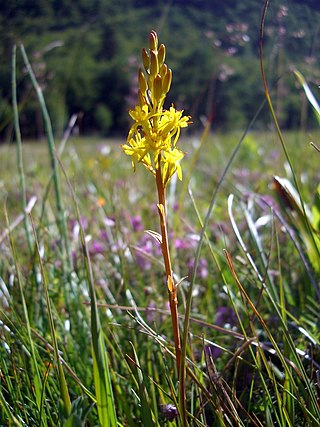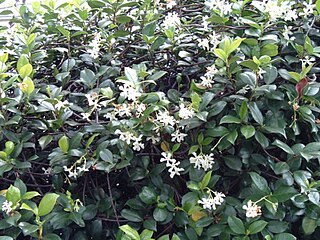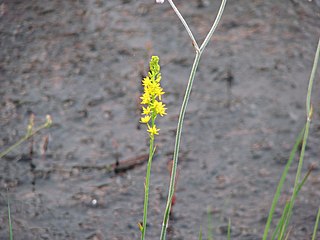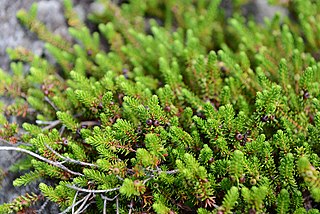
Royal Botanic Gardens, Kew is a non-departmental public body in the United Kingdom sponsored by the Department for Environment, Food and Rural Affairs. An internationally important botanical research and education institution, it employs 1,100 staff. Its board of trustees is chaired by Dame Amelia Fawcett.

Nartheciaceae is a family of flowering plants. The APG III system places it in the order Dioscoreales, in the clade monocots. As circumscribed by APG IV (2016) it includes 35 species of herbaceous plants in the following five genera:

Crinum is a genus of about 180 species of perennial plants that have large showy flowers on leafless stems, and develop from bulbs. They are found in seasonally moist areas, including marshes, swamps, depressions and along the sides of streams and lakes in tropical and subtropical areas worldwide.

Zosteraceae is a family of marine perennial flowering plants found in temperate and subtropical coastal waters, with the highest diversity located around Korea and Japan. Most seagrasses complete their entire life cycle under water, having filamentous pollen especially adapted to dispersion in an aquatic environment and ribbon-like leaves that lack stomata. Seagrasses are herbaceous and have prominent creeping rhizomes. A distinctive characteristic of the family is the presence of characteristic retinacules, which are present in all species except members of Zostera subgenus Zostera.

Anthericum is a genus of about 65 species, rhizomatous perennial plants in the family Asparagaceae, subfamily Agavoideae. It was formerly placed in its own family, Anthericaceae. The species have rhizomatous or tuberous roots, long narrow leaves and branched stems carrying starry white flowers. The members of this genus occur mainly in the tropics and southern Africa and Madagascar, but are also represented in Europe.

Narthecium is a Eurasian and North American genus of herbaceous flowering plants. This genus was traditionally treated as belonging to the family Liliaceae, but the APG II system of 2003 placed it in the family Nartheciaceae.

Narthecium ossifragum, commonly known as bog asphodel, Lancashire asphodel or bastard asphodel, is a species of flowering plant in the family Nartheciaceae. It is native to Western Europe, found on wet, boggy moorlands up to about 1,000 m (3,300 ft) in elevation. It produces spikes of bright yellow flowers in summer. The bright orange fruits have been used as a colourant to replace saffron by Shetland Islanders. Despite the plant's English name "bog asphodel", it is not particularly closely related to the true asphodels. In addition to other forms of pollination, this plant is adapted to rain-pollination. The Latin specific name ossifragum means "bone-breaker", and refers to a traditional belief that eating the plant caused sheep to develop brittle bones. The probable origin of this story is that sheep eating a calcium-poor diet are likely to develop bone weakness, and N. ossifragum favours acidic low-calcium soils.

Galium verum is a herbaceous perennial plant of the family Rubiaceae. It is widespread across most of Europe, North Africa, and temperate Asia from Israel, Lebanon and Turkey to Japan and Kamchatka. It is naturalized in Tasmania, New Zealand, Canada, and the northern half of the United States. It is considered a noxious weed in some places.

Trachelospermumstar jasmine, Confederate jasmine, is a genus of evergreen woody vines in the dogbane family Apocynaceae, first described as a genus in 1851. All species are native to southern and eastern Asia.

Ulmus davidiana var. japonica, the Japanese elm, is one of the larger and more graceful Asiatic elms, endemic to much of continental northeast Asia and Japan, where it grows in swamp forest on young alluvial soils, although much of this habitat has now been lost to intensive rice cultivation.

Narthecium americanum is a species of flowering plant in the Nartheciaceae known by the common names yellow asphodel and bog asphodel. It is native to New Jersey in the United States. It is now apparently limited to that state, having likely been extirpated from Delaware, North Carolina, and South Carolina.

Crinum pedunculatum also known as the swamp lily, river lily or mangrove lily, is a bulbous perennial found in stream and tidal areas of the Northern Territory, Queensland and New South Wales, Australia as well as New Guinea and some Pacific Islands. It is unclear whether it is native or introduced to Norfolk Island.

Empetrum nigrum, crowberry, black crowberry, or, in western Alaska, blackberry, is a flowering plant species in the heather family Ericaceae with a near circumboreal distribution in the Northern Hemisphere. It is usually dioecious, but there is a bisexual tetraploid subspecies, Empetrum nigrum subsp. hermaphroditum, which occurs in more northerly locations and at higher altitude.

Crinum asiaticum, commonly known as poison bulb, giant crinum lily, grand crinum lily, or spider lily, is a plant species widely planted in many warmer regions as an ornamental. It is a bulb-forming perennial producing an umbel of large, showy flowers that are prized by gardeners. However, all parts of the plant are poisonous if ingested. Some reports indicate exposure to the sap may cause skin irritation.
Narthecium californicum is a species of flowering plant known by the common name California bog asphodel. It is native to the mountains of southern Oregon and northern California, where it grows in wet habitat such as streambanks and meadows. It is a rhizomatous perennial monocot producing an erect stem up to about 60 centimeters tall. The base of the plant is surrounded by linear, grasslike leaves up to 30 centimeters long. The inflorescence is a raceme of many yellow flowers with six pointed tepals no more than a centimeter long. The fruit is a lance-shaped capsule containing many bristle-tailed seeds.

Kew Gardens is a botanic garden in southwest London that houses the "largest and most diverse botanical and mycological collections in the world". Founded in 1840, from the exotic garden at Kew Park, its living collections include some of the 27,000 taxa curated by Royal Botanic Gardens, Kew, while the herbarium, one of the largest in the world, has over 8.5 million preserved plant and fungal specimens. The library contains more than 750,000 volumes, and the illustrations collection contains more than 175,000 prints and drawings of plants. It is one of London's top tourist attractions and is a World Heritage Site.

Zanthoxylum asiaticum is a species of plant in the family Rutaceae. Under its synonym Toddalia asiatica, it was the only species in the monotypic genus Toddalia, now included in Zanthoxylum. It is known by the English name orange climber.

Trachelospermum asiaticum, the Asiatic jasmine, is a species of flowering plant in the family Apocynaceae and it is native to Asia. Its flowers resemble stars, so it is also referred to as yellow star jasmine or Asian star jasmine. This is a fast growing evergreen vine, often used to cover fences, walls, and similar surfaces. It is heat- and cold- tolerant, and grows even in shady areas.

Empetrum nigrum subsp. asiaticum, the Korean crowberry, is a subspecies of the flowering plant species Empetrum nigrum in the heather family, Ericaceae. The plant is called siromi (시로미) in Korean and gankōran (岩高蘭) in Japanese.
Crinum bakeri is a species of flowering plant in the amaryllis family Amaryllidaceae, native to the Caroline Islands and the Marshall Islands. It was first described by Karl Moritz Schumann in 1887. It is probably a synonym for Crinum asiaticum var. asiaticum.


















